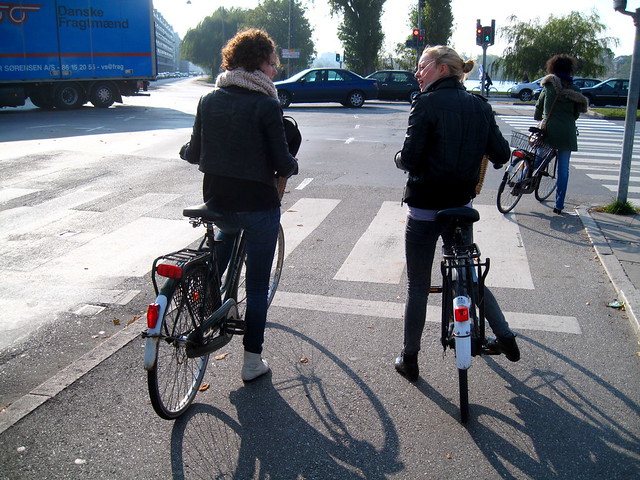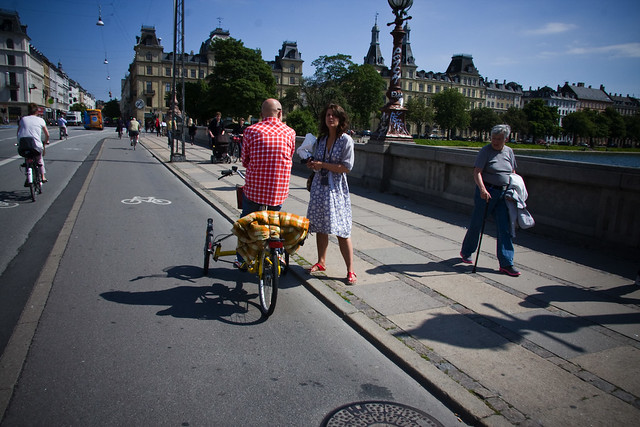

“Hi… excuse me… can you help me find this address?” An oft-used phrase for visitors in a foreign city. A few months ago I met up with Andy Cutler from Providence, RI, who was in Denmark to explore opportunities for Providence and Copenhagen to hook up on a creative and business level.
He did a cool little experiement. He was here for two weeks and only got around by asking people on the street for directions, instead of using tech-gadgets. He wrote about it here, on the Better World by Design blog.
He told me about it at Bang & Jensen café in Copenhagen one evening and I thought it to be cool.
One of his observations is that Copenhageners - besides being helpful - never really gave him complete and specific directions. They sent him in the right direction and then suggested he ask someone else for further details once he got closer. I found that interesting.I've spent a awful lot of time thinking about it since then. Making mental notes of my own experiences. Asking friends about their wayfinding habits. In addition, I've been using a valuable resource at my disposal - all the guests who stay with me in my flat, my Airbnb room.
The baseline of my observations it that Copenhageners aren't very good with street addresses. They'll rarely be able to tell you what house number a certain establishment is at on a certain street. Street names, too, are not something that roll right off the tongue when describing how to get somewhere. We live in densely-populated neighbourhoods with pretty much everything we need in close proximity to us. There are fixed points on our personal maps, sure. Supermarkets, cafés, banks (although less so these days with online banking), busstops, train stations, parks. When something new appears on our map, people have to start telling each other how to get there. A new café or restaurant, for example."I was at this cool, new restaurant last night. It was great."
"I've read about it, heard good things about it. Where is it?" At this point a street name will, most likely, come into the conversation but rarely a house number. The description of the restaurant location will involve describing the new place's proximity to other established points on our urban map.
"It's just up from XXX supermarket. You know... near XXX café."
"Okay. Which side of the street? Heading towards the city or away from it?" You'll never get a specific location. You'll end up riding your bike to the new restaurant and, as you approach, you'll narrow down your wayfinding using the locations of the known establishments and finally spotting the sign for the new restaurant. I've played around with friends and colleagues, asking them if they know a certain place and how to get there. In fifty or so attempts, this is the overwhelmingly the pattern.
I also discovered that I didn't know the exact street address of my regular haunts. Cafés, resturants, etc.. I often send visitors to the aforementioned Bang & Jensen café - a place I've been frequenting for over a decade. I seem to recall that the house number was over 100 and, when describing the location I'll mention some cross streets but I'll mostly mention shop names nearby by. Little pins on a mental map that will help the person find the place. If neccessary I will say "the house number is over 100", in order to help them more specifically.
I just googled it and found out it's at Istedgade 130. I'm sure I'll forget that by the end of the day. I've also been asking my Airbnb guests if they asked anyone for directions while out in the city. If yes, I've asked what kind of response they got. Again, the same pattern emerged. Copenhageners were helpful but described things around the desired destination. Visual and textual clues to help them narrow the wayfinding journey. I also catch myself telling them how to get to places using visual references."It's just after a green building. There's a supermarket with a big sign reading FØTEX. It's just after that. Heading towards the city, not away from it." And so on.
So what's up with this? Here's what I think.Copenhageners are't shockingly bad at finding their way. Of course not. We're Vikings... we discovered America and sailed at will around the known world, as though we designed it ourselves. We invented the first compass - the Viking Sunstone. :-)
Nah... here's the thing. Copenhagen is a city of densely-populated neighbourhoods. It's a city where 71% of the population do not own a car and they transport themselves around their urban landscape on bicycles. In their local neighbourhoods there's a lot of walking. We spend great amounts of time not sitting in boxes of steel and glass with restricted vision but on the cycle tracks and sidewalks - or even on busses staring out of the window. Our wayfinding is visual. Shop signs, building colours, proximity to fixed points on the map like train station or parks. With so much time spent looking at our city from the seats of our bicycles, the need for specifics like street names and house numbers dwindles. In communicating wayfinding to others, we describe the visual images imprinted on our inner map in our head.Mistakes may occur. "You said past the green building... that's not green, that's blue..." Or you discover that the café across the street from the desired destination closed down and is now a flower shop, throwing us off our wayfinding.
Not to worry. Just stop somebody on the street and get some more visual clues. You'll get there eventually. And your journey will be a human one, worthy of a truly liveable city. I've noticed the same patterns in other cities like Amsterdam. Few street names are mentioned, just visual directions involving establishments, certain bridges, etc. Bicycle-friendly cities allow a closer contact with the city for those living in it - or visiting it. They are cities that are imprinted more indelibly on the retina of our inner cartographer. I like that. It's human. Addendum: Then there is the whole human aspect of how being closer to your city on bicycles drastically increases your chances of spotting friends - and stopping to say hello. You see it all the time. Someone on a bicycle chatting with a friend on the sidwalk. Or two bicycle users who ran into each other and are having a chat on the sidewalk.A bizarre coincedence just yesterday... I was heading to the beach with the kids and, at a roundabout, a man in a pedicab hailed me down. He - and the pedicab rider - wanted to know where the Bicycle Innovation Lab was. They decided to ask the first person they spotted. That was me.
Bizarre, because I was involved in starting the Bicycle Innovation Lab - the first cultural centre for cycling - and the Bicycle Library. Even more bizarre because the man in the pedicab was my friend Karta from London. He runs, among other things, The Bicycle Library in London.
It was a wild, unfathomable coincedence. He is in town for 24 hours, having flown in from Hong Kong. And boom... I'm the guy he spots on the cycle track to ask about the whereabouts of the Bicycle Innovation Lab. Even more bizarre, as we're standing there talking on the cycle track, my two German guests in my flat from Airbnb roll up behind us. Little Lulu, sitting on the Bullitt, said, "Look, Daddy... it's our guests." They were heading to the beach, too. There's no way I'm playing the lottery. I've used up my wild odds on a roundabout in Copenhagen.




